
The hands of Albert Einstein: handprints of left hand & right hand!

JANUARY 28, 2009
Handprints: the hands of Albert Einstein!
What do the hands of Albert Einstein reveal about his independent personality, his suspected autism & his presumed left-handedness?'
Author: Martijn van Mensvoort
(Special thanks to: hand reader: Manfred Magg from Germany, who made the copy of Einstein's handprints available)
In this article we'll take a look at the (signed) handprints of Albert Einstein: the right- & left handprint are presented at the bottom of this artcle. Einstein's handprints were taken around 1930 by a German hand reader Marianne Raschig, and are presented in her book Hand und Persönlichkeit. The hands of Einstein show some rather remarkable characteristics which can be related to his his personality, his suspected autism & his presumed left-handedness.
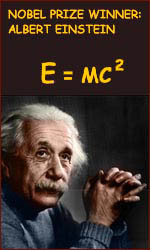
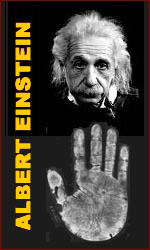
THE HANDS OF ALBERT EINSTEIN: AN OVERVIEW IN 5 STEPS
First, this review will describe why Albert Einstein became famous. Second, we'll find out what Albert Einstein's hands reveal about his independent personality. Third, we'll discover two hand characteristics which can be related to the believes of UK researchers that Albert Einstein displayed signs of autism. Fourth, both hands reveal evidence that Einstein indeed had an inclination to left-handedness. And finally, I'll presents some other reviews of Albert Einstein's hands presented by some experienced hand experts.
• 1 - Who was Albert Einstein?
• 2 - The hands of Einstein & his independent personality!
• 3 - The hands of Einstein & his suspected autism
• 4 - The hands of Einstein & his presumed left-handedness
• 5 - Professional hand readers about the hands of Einstein
• 1 - WHO WAS ALBERT EINSTEIN?
Who was Albert Einstein? In 1999 Time Magazine named Albert Einstein as the "Person of the 20th Century", for Einstein became THE pre-eminent scientist in a century dominated by science.
The touchstones of the area of science - the Bomb, the Big Bang, quantum physics and electronics - all bear Alber Einstein's imprint.
In wider culture the name "Einstein" has become synonymous with genius, after winning the Nobel prize in Physics (1921) he became best known for his equation for the mass-energy equivalence: E = mc2.
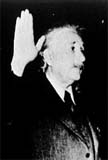
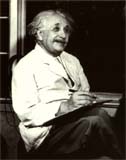
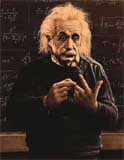
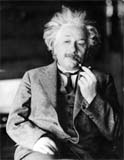

Albert Einstein doing various 'hand activities' - from older to younger age.
• 2 - THE HANDS OF EINSTEIN & HIS INDEPENDENT PERSONALITY!
Obviously the work of Einstein proves that he was one of the great thinkers of the 20th century.
And Einstein was also recognized by The Independent as one of most well-known independent thinkers ever.
But in his private life 'Einstein - the independent thinker' also became manifest:
For example, despite his mother's prejudice against Serbs and thought about Mileva Maric of being "too old" and "physically defective, Einstein decided to mary this Serbian woman - his first wife, who was also a physician.
And Albert Einstein also saw himself as an independent thinker. For in a famous letter to his first wife Einstein described her as:
"... a creature who is my equal and who is as strong and independent as I am."
How to recognize an 'independent thinker' from any hand?
In classic hand reading an 'independent thinker' is usually associated with an independent head line - this is when the head line (green line in the picture on the left) is seperated to the life line (blue line in the picture on the left).
In this perspective it is interesting to notice that both hands of Albert Einstein show that specific feature which can be related to 'Einstein - the independent thinker': in both hands the so-called 'head line' [in medics: lower transversal crease] is not connected to the so-called 'life line' [in medics: tenar crease].
Two other hand features have been associated with 'independent thinking' are:
• The 'whorl' fingerprint on the index finger: Einstein has a (plain) whorl fingerprint on both index fingers. By the way, Einstein has the 'whorl' fingerprint type on most of his fingers; only the right middle finger + both pinky fingers have a (ulnar) 'loop'.
• When the index finger stands away from the other fingers: "... it signals independence and originality": this hand characteristic is present in the left handprint of Albert Einstein - though this might be a matter of 'coincidence': the other fingers + thumbs are not 'leaning away' at all.

• 3 - THE HANDS OF EINSTEIN & HIS SUSPECTED AUTISM
Researchers at Cambridge and Oxford universities believe Albert Einstein displayed signs of Asperger's Syndrome - the higher functioning variant of autism which often manifests in "eccentric" behaviour rather than pronounced and obvious disability.
Many people with Asperger syndrome are often regarded as being eccentric. They sometimes lack social skills, are obsessed with complex topics and can have problems communicating.
According to the UK researchers, Einstein showed signs of Asperger's from a young age. Einstein spoke his first words at age 4: "The soup is too hot". Greatly relieved, his parents asked why he had never said a word before. Albert replied: "Because up to now everything was in order". As a child, Albert Einstein was a loner and often repeated sentences obsessively until he was seven years old. He was also a notoriously confusing lecturer.
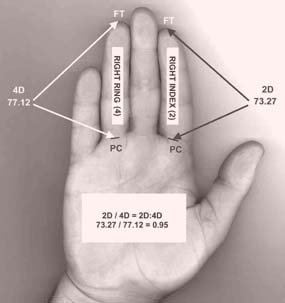
How to recognize autism from any hand?
According the UK psychologist John T. Manning finger lengths may yield clues to the cause of autism & Asperger syndrome.
An extreme low digit ratio of 0.94 or lower (the picture on the right shows how to measure the 2D:4D digit ratio), has been associated with Autism, suggesting that excessive prenatal testosterone may play a causal role in the development of autism (Manning et al., 2001)
In this perspective it is interesting to notice that the 2D:4D digit ratio in both hands of Einstein is close to 0.93 - far below the average of 0.96 for men (1.00 for women).
However, there are other hand characteristics which have been related to autism.
Various studies have been published focussed on the relationship between autism & the fingerprints, palmar dermatoglyphics + palmar lines; various studies have reported significant results.
And other studies have reported that minor physical anomalies are more often seen in the bodies of people who have autism.
Abnormal palmar lines such as the 'simian crease' (or: simian line) and the 'Sydney line' (or: Sydney crease, an extremely long 'head line' which end at the side of the palm) are included in the list of minor physical anomalies.
In the perspective of these studies it is interesting to notice here that Albert Einstein had a Sydney crease in his left hand (though it's not a complete Sydney line: at the end a big 'island' construction of several lines reaches out to the side of the palm).
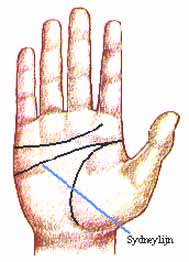
The Sydney line: a fascinating hand mark!
• 4 - THE HANDS OF EINSTEIN & HIS PRESUMED LEFT-HANDEDNESS
Albert Einstein's handedness is a subject of some debate. Obviously, Einstein wrote with his right hand. But many believe that Einstein was a lefty who was forced to write with his right hand.
So far, the evidence for Einstein's left-handedness came from 2 directions:
• Many observations & photos reports are available of Einstein doing activities with his left hand, such as: smoking his pipe, finger counting & drinking (see the photos presented at the beginning of this article).
• In 2000 the first anatomical study of Einstein's brain was conducted; neuroscientist Sandra Witelson [quote 23] found that the two hemispheres of his cortex, particularly the language centers, were more symmetrical than asymmetrical - which is a characteristic to be more prevalent in the left-handed.
How to recognize left-handedness from any hand?
Only a few years ago I discovered that right-left hand asymmetries provide various strong clues on handedness.
In my research on left handedness I have described with significant evidence that the thumb length, finger length & palm length + width appear to be related to handedness of a person.
More specific: in left-handedness one can expect on the LEFT hand: LONGER finger + thumb length, a WIDER palm width, and a SHORTER (!) palm.
In right-handedness one can expect the reverse for the RIGHT hand.
In this perspective it is interesting to notice that some rather remarkable right-left asymmeties (see the red dots in the picture below):
• FINGER LENGTH:
In Einstein's left hand all fingers are much longer compared to the right hand: +5% or more (in the middle finger the R-L asymmetry appears to be almost +8%);
• THUMB LENGTH:
It is fairly impossible to measure the full thumb length from a handprint. Nevertheless, in Einstein's hands the nail phalange of the left thumb appears to be much longer than the nail phalange of the right thumb: +6%;
• PALM WIDTH:
The palm width appears to be equal for both hands (measured from the start of the life line: see the red dots in the picture below)
• PALM LENGTH:
It is fairly impossible to measure the palm length from a hand print (by the way, the bottom of Einstein's right handprint appears to be incomplete).
NOTICE: Additional comments on the R-L asymmetries in the width of the individual fingers:
• Thumb + little finger: more wide in the left hand;
• Ring finger: no significant R-L asymmetry;
• Index finger + middle finger: more wide in the right hand.
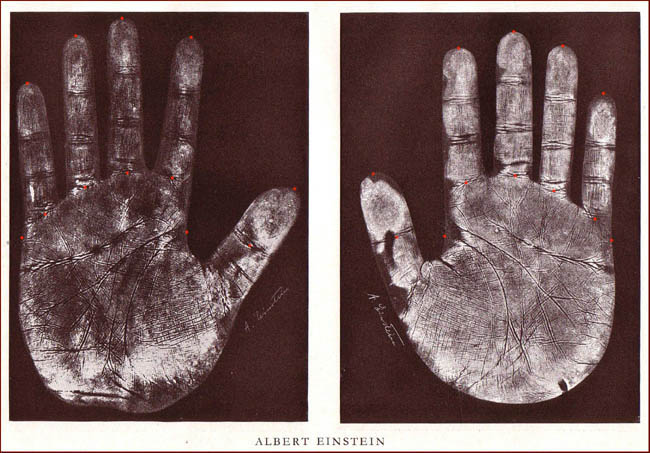
(NOTICE: the red dots were added for the purpose of the present article)
Higher quality hand prints are presented at the bottom of this page:
Albert Einstein's right hand - Albert Einstein's left hand
• 5 - PROFESSIONAL HAND READERS ABOUT THE HANDS OF EINSTEIN!
Over the years various hand experts have presented their 'hand analysis' of Albert Einstein's hands. Some interesting observations & conclusions are presented by:
• Hand analyst Richard Unger (see his book titled 'LifePrints')
• Fingerprint expert Andres J. Washington: The handprints of Dr. Albert Einstein.
• Chirologist Arnold Holtzman: 'The signed handprints of Albert Einstein;
By the way, another handprint of Einstein's right hand was made by the French palmist Noel Jaquin; this palm print is presented on the cover + inside Jaquin's book "The signature of time" (1940) and ; later also published as: "Secrets of handreading" (1965).
THE HANDPRINT OF ALBERT EINSTEIN'S RIGHT HAND PRINT
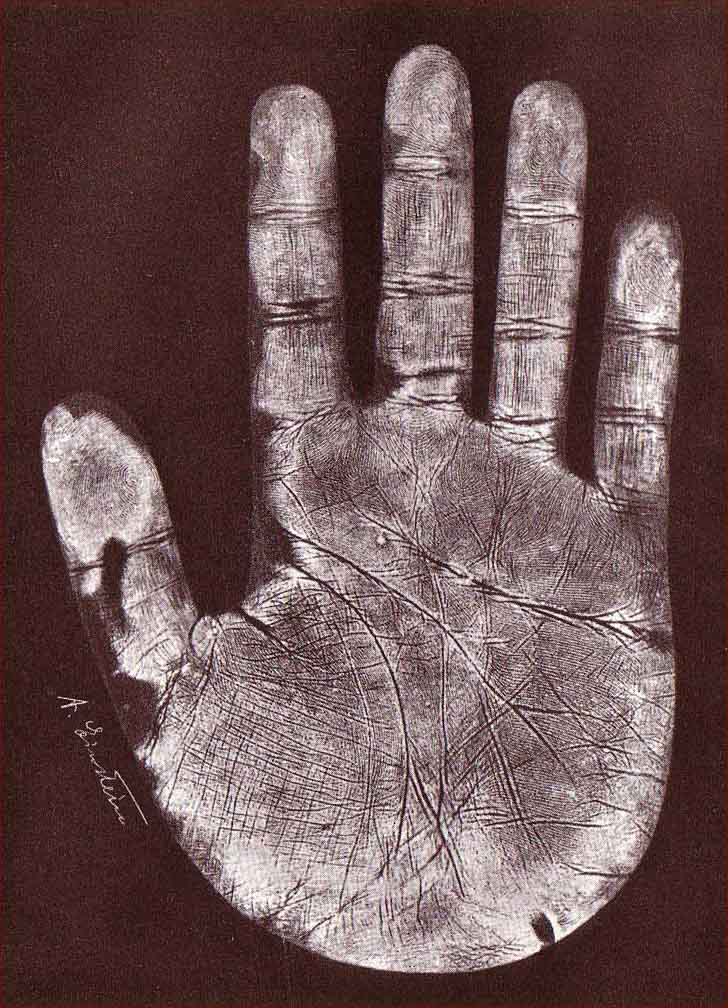
THE HANDPRINT OF ALBERT EINSTEIN'S LEFT HAND PRINT
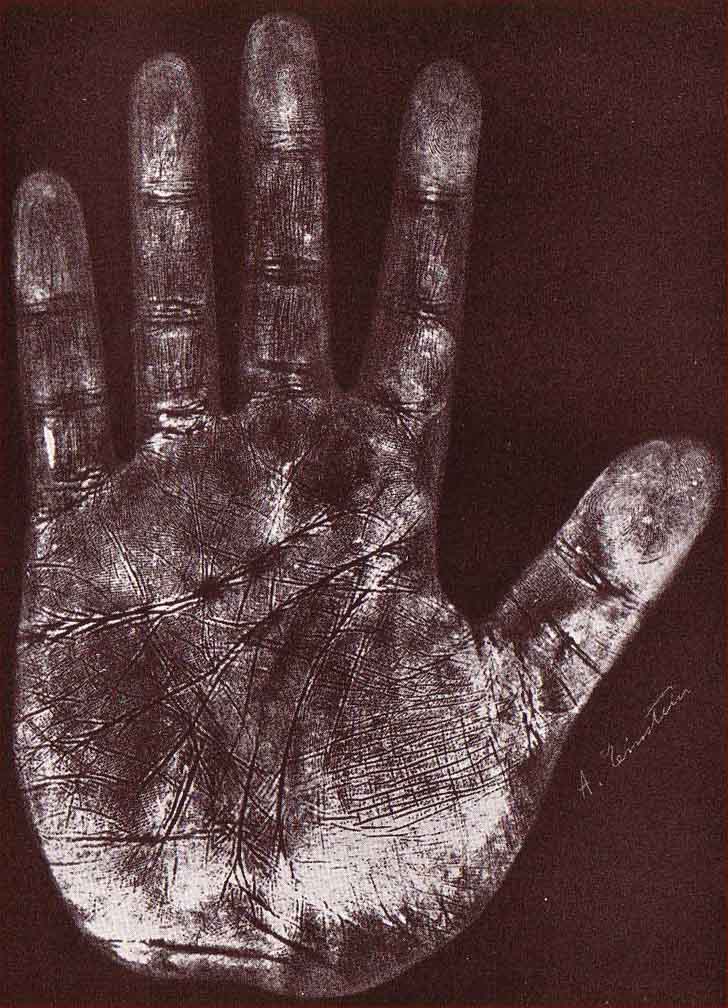
More about famous hands & rather remarkable hand features:
Celebrity handprints
Lending a hand for charity
Hands & autism: digit ratio, fingerprints & dermatoglyphics
Handedness, finger length & hand shape asymmetry
The Hands of 'mirror' twins
The simian line: a notorious hand crease
Richard Unger presents: Lifeprints - deciphering your life purpose from your fingerprints
Arnold Holtzman presents: PsychoDiagnostic Chirology
The world's largest hands ever!
Handprints: the hands of Albert Einstein